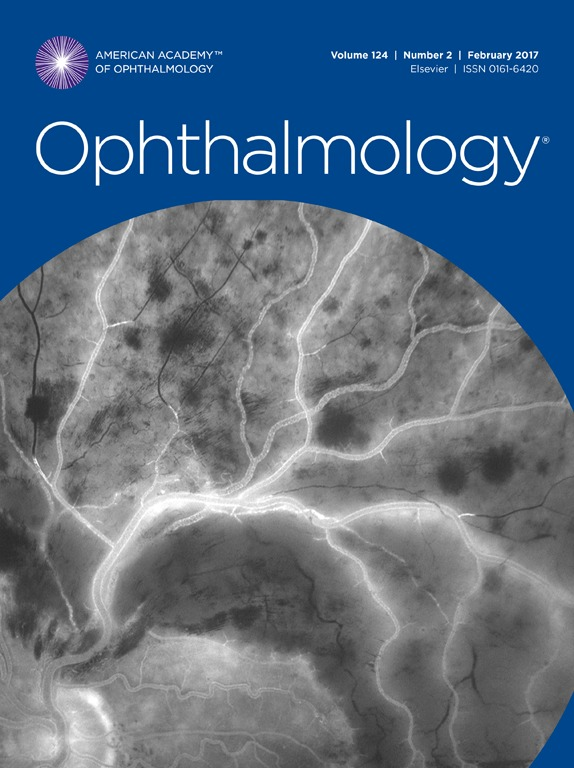口服抗氧化剂和叶黄素/玉米黄质补充剂可延缓老年性黄斑变性患者眼窝的地理萎缩进程
IF 13.1
1区 医学
Q1 OPHTHALMOLOGY
引用次数: 0
摘要
本文章由计算机程序翻译,如有差异,请以英文原文为准。
Oral Antioxidant and Lutein/Zeaxanthin Supplements Slow Geographic Atrophy Progression to the Fovea in Age-Related Macular Degeneration
Purpose
To determine whether oral micronutrient supplementation slows geographic atrophy (GA) progression in age-related macular degeneration (AMD).
Design
Post hoc analysis of Age-Related Eye Disease Study (AREDS) and AREDS2, multicenter randomized placebo-controlled trials of oral micronutrient supplementation, each with 2 × 2 factorial design.
Participants
A total of 392 eyes (318 participants) with GA in AREDS and 1210 eyes (891 participants) with GA in AREDS2.
Methods
The AREDS participants were randomly assigned to oral antioxidants (500 mg vitamin C, 400 IU vitamin E, 15 mg β-carotene), 80 mg zinc, combination, or placebo. The AREDS2 participants were randomly assigned to 10 mg lutein/2 mg zeaxanthin, 350 mg docosahexaenoic acid/650 mg eicosapentaenoic acid, combination, or placebo. Consenting AREDS2 participants were also randomly assigned to alternative AREDS formulations: original; no beta-carotene; 25 mg zinc instead of 80 mg; both.
Main Outcome Measures
(1) Change in GA proximity to central macula over time and (2) change in square root GA area over time, each measured from color fundus photographs at annual visits and analyzed by mixed-model regression according to randomized assignments.
Results
In AREDS eyes with noncentral GA (n = 208), proximity-based progression toward the central macula was significantly slower with randomization to antioxidants versus none, at 50.7 μm/year (95% confidence interval [CI], 38.0–63.4 μm/year) versus 72.9 μm/year (95% CI, 61.3–84.5 μm/year; P = 0.012), respectively. In AREDS2 eyes with noncentral GA, in participants assigned to AREDS antioxidants without β-carotene (n = 325 eyes), proximity-based progression was significantly slower with randomization to lutein/zeaxanthin versus none, at 80.1 μm/year (95% CI, 60.9–99.3 μm/year) versus 114.4 μm/year (95% CI, 96.2–132.7 μm/year; P = 0.011), respectively. In AREDS eyes with any GA (n = 392), area-based progression was not significantly different with randomization to antioxidants versus none (P = 0.63). In AREDS2 eyes with any GA, in participants assigned to AREDS antioxidants without β-carotene (n = 505 eyes), area-based progression was not significantly different with randomization to lutein/zeaxanthin versus none (P = 0.64).
Conclusions
Oral micronutrient supplementation slowed GA progression toward the central macula, likely by augmenting the natural phenomenon of foveal sparing.
Financial Disclosure(s)
Proprietary or commercial disclosure may be found after the references.
求助全文
通过发布文献求助,成功后即可免费获取论文全文。
去求助
来源期刊

Ophthalmology
医学-眼科学
CiteScore
22.30
自引率
3.60%
发文量
412
审稿时长
18 days
期刊介绍:
The journal Ophthalmology, from the American Academy of Ophthalmology, contributes to society by publishing research in clinical and basic science related to vision.It upholds excellence through unbiased peer-review, fostering innovation, promoting discovery, and encouraging lifelong learning.
 求助内容:
求助内容: 应助结果提醒方式:
应助结果提醒方式:


